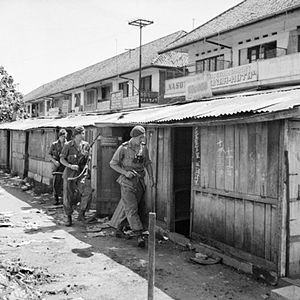5th Parachute Brigade (United Kingdom)
| 5th Parachute Brigade | |
|---|---|

Men of the 5th Parachute Brigade on patrol in Batavia
|
|
| Active | 1943–1946 |
| Country |
|
| Branch |
|
| Type | Parachute Infantry |
| Role | Airborne forces |
| Size | Brigade |
| Part of |
6th Airborne Division 23rd Indian Infantry Division |
| Nickname(s) | Red Devils |
| Engagements |
Normandy landings Operation Deadstick Operation Tonga Operation Paddle Battle of the Bulge Operation Varsity Advance to the Baltic Operation Zipper Operation Tiderace Operation Pounce |
| Commanders | |
| Notable commanders |
Brigadier Nigel Poett |
| Insignia | |
| Emblem of the British airborne forces |
 |
The 5th Parachute Brigade was an airborne forces formation of brigade strength, raised by the British Army during the Second World War. Created during 1943, the brigade was assigned to the 6th Airborne Division, serving alongside the 3rd Parachute Brigade and the 6th Airlanding Brigade.
The brigade first saw action in the British airborne landings on D-Day Operation Tonga, where it was responsible for capturing bridges over the Caen Canal and the River Orne in Operation Deadstick. The brigade remained in Normandy until September 1944, by which time it had advanced to the mouth of the River Seine. Its next engagement was in reaction to the surprise German offensive in the Ardennes, the Battle of the Bulge. This was followed by Operation Varsity, the last Allied airborne mission of the war. After this, the brigade advanced across Germany, reaching the Baltic Sea by the end of fighting in the European theatre.
The brigade was then sent to India as the division's advance party, but the war ended before it could begin operations. Instead the brigade became involved in disarming the Japanese forces in Malaya and Singapore, to restore British sovereignty. Its last operation was in Java, where it remained until a Dutch force arrived to take over. The brigade then rejoined the 6th Airborne Division, which was serving in Palestine, but was disbanded almost immediately afterwards.
...
Wikipedia
